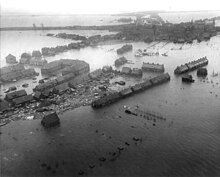 Aftermath of the flood in Oude-Tonge, Goeree-Overflakkee, Netherlands | |
| Meteorological history | |
|---|---|
| Duration | 31 January – 1 February 1953 |
| Overall effects | |
| Fatalities | 2,551 |
| Damage | 9% of total Dutch farmland flooded, 187,000 animals drowned, 47,300 buildings damaged of which 10,000 destroyed |
| Areas affected | Netherlands, Belgium, United Kingdom |

The 1953 North Sea flood (Dutch: Watersnoodramp) was a major flood caused by a heavy storm surge that struck the Netherlands, north-west Belgium, England and Scotland. Most sea defences facing the surge were overwhelmed, resulting in extensive flooding.
The storm and flooding occurred during the night of Saturday, 31 January to the morning of 1 February, 1953. A combination of a high spring tide and a severe European windstorm caused a storm tide of the North Sea. The combination of wind, high tide, and low pressure caused the sea to flood land up to 5.6 metres (18 ft 4 in) above mean sea level.
Realising that such infrequent events could reoccur, the Netherlands and the United Kingdom carried out large studies on strengthening of coastal defences. The Netherlands developed the Delta Works, an extensive system of dams and storm surge barriers. The UK constructed storm surge barriers on the Thames Estuary and on the Hull where it meets the Humber Estuary.